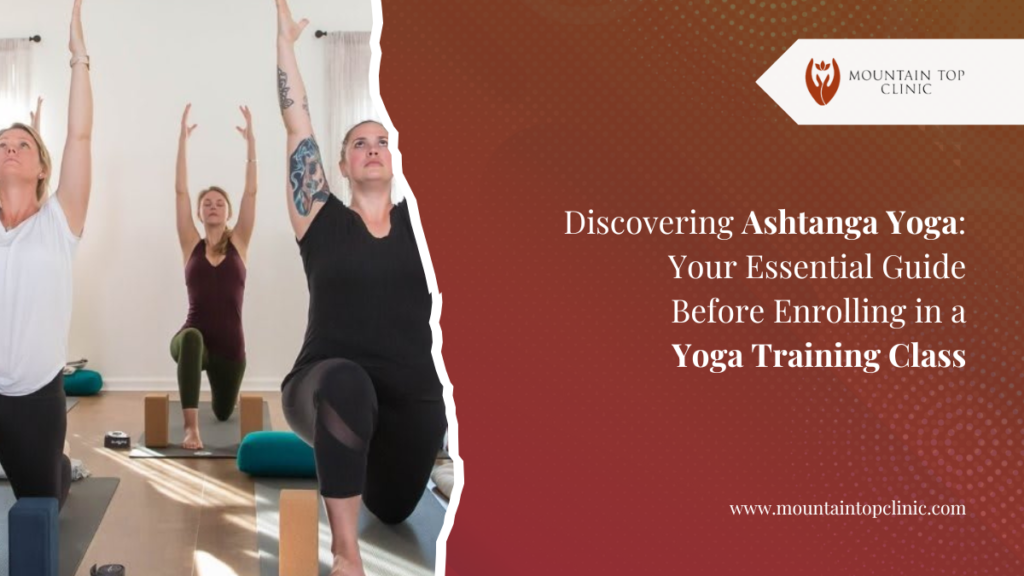
Yoga is a versatile art form with a multitude of benefits to explore. You can read about the five most popular Yoga styles, including Ashtanga Yoga, in our blog here.
If weight loss is your goal and you’re considering Yoga training in Nilgiris, Ashtanga Yoga is an excellent choice. This style holds a ton of fascinating elements. This blog is your gateway to uncovering essential insights to the array of advantages that Ashtanga Yoga offers. Let’s uncover some interesting Yoga facts!
Ashtanga Yoga: A Definitive Guide
The Yoga Sutras describe Ashtanga Yoga as a classical form of Yoga that signifies an “eightfold path”. The ancient text that holds these Yoga secrets explains that there are eight branches or steps following which one can embark upon the journey of self-awakening and the ultimate step is Samadhi.
Let’s learn about this “eightfold path,” or the eight steps of Ashtanga Yoga. Visit an Ayurvedic wellness center to learn this Yoga style.
What are the eight limbs or steps of Ashtanga Yoga?
- Yama or Yamas: The first path according to this Yoga principle is Yama or Yamas. It encourages the practice of ethical behavior towards others.
- Niyama or Niyamas: This is the second step that involves moral self-discipline.
- Asana: The third step is asana, which involves practicing different postures without any pain or discomfort. The mind remains focused on the posture and the body reaches a relaxed, comfortable state.
- Pranayama: It is the fourth step and involves controlling one’s breathing. One learns to regulate breathing to achieve calmness of mind. It helps in mind detox as well.
- Pratyahara: In this fifth stage, one learns to turn their attention inward after freeing the mind of all sensory stimuli. The aim is to shut out the sensory world and focus on your inner state.
- Dharana: This is the sixth step or limb where the mind learns to concentrate without wandering. One needs to focus on a specific object.
- Dhyana: The seventh limb or step of Asthanga Yoga is Dhyana or meditation. It is a continuation of the previous state where the mind stays focused on an object.
- Samadhi: In this eighth and final step, an individual’s consciousness unifies with the cosmic power.
What is Ashtanga Yoga practice?
An Ashtanga Yoga practice session performed at the best Ayurvedic retreats in India generally is accompanied with a separate calming meditation session.
What is the significance of Ashtanga Yoga?
This Yoga style works on many levels – it boosts your physical health, clears away any mental blocks and offers mental clarity, thereby enhancing your overall well-being.
What are the benefits of Ashtanga Yoga?
If you remain consistent with your Ashtanga Yoga practice, you will reap many benefits in the long run. Let’s take a look at some of the key benefits.
- Become physically stronger
If you want to build physical strength and flexibility, this is the right Yoga style. Your core muscles will become strong and toned. Consistent practice will help you become more flexible, which helps prevent injury.
- Reduce stress
Pranayama and meditation at an Ayurvedic wellness center require regulation of breathing and increased attention. This helps reduce stress, control anxiety and calm the mind. With regular practice, you will notice that your focus and concentration levels improve,and you feel more relaxed. Join a session of Yoga training in Nilgiris today to start experiencing these benefits.
- Become mindful
Throughout an Ashtanga Yoga training session, your attention remains anchored to the rhythm of your breath, firmly grounding you in the present. This practice cultivates heightened mindfulness, forging a bond between your mind, body and spirit. Moreover, your self-awareness experiences a notable expansion as well.
While Ashtanga Yoga training can be demanding, its rewards are boundless. To harness its full potential, consider enrolling for Yoga training in Nilgiris, guided by experts. Under their guidance, you’ll practice with precision and if you encounter challenges, your instructor is there to assist. Always remember, while practicing, it is important to maintain proper form and postures to prevent injuries.
ALSO, YOU CAN READ OUR NEW UPDATES
- Stress management is a must for holistic wellness: follow these tips to handle stress
- 5 reasons why you should try ayurvedic wellness programs this year
- How to start meditation? Here are a few tips to start meditation for wellness!
- Ayurvedic diet for wellness: what are the rules to follow?
- Yoga training for beginners: keep these pointers in mind
- Here are some holistic healing tips that you must check out now!
- Unlocking the power of nutrition: how your diet impacts your health
- Discover the magic of ayurvedic herbs: 6 powerful remedies for wellness
- Beginners guide to yoga styles: join a yoga training class to find your style
- 6 essential tips to safely enhance your yoga training and prevent injuries
- All you need to know about the International Day of Yoga
- The five benefits of an ayurvedic oil massage
- Discover Shirodhara in Ayurveda: An insight into Panchakarma’s revitalising detox treatment
- Discover timeless beauty secrets: ayurveda’s powerful anti-aging solutions
- A comprehensive guide to the different branches of ayurveda

